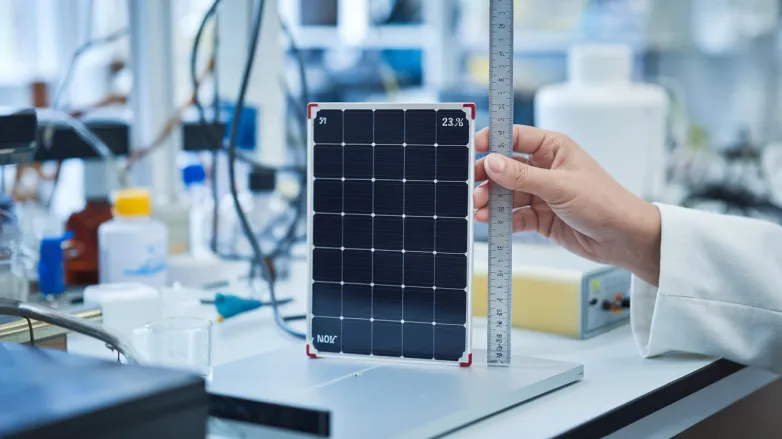New Method Boosts Tandem Solar Cell Efficiency to 33.1%
- Breakthrough in solar technology: A revolutionary 33.10% efficient tandem solar cell merges perovskite and silicon, boasting enhanced durability and performance through innovative surface reconstruction methods.

Researchers from Huaqiao University and other institutions have developed a four-terminal perovskite/silicon tandem solar cell achieving a remarkable efficiency of 33.10%. The cell features a perovskite-based top layer with a bandgap of 1.67, integrated with a hybrid back contact silicon solar cell. A novel surface reconstruction method utilizing wet nano-polishing was employed to reduce surface defects, enhancing the interface quality and overall device performance.
The newly designed tandem solar cell retains over 80% of its initial efficiency after extensive testing, demonstrating durability under prolonged illumination. Two cell variations—opaque and semi-transparent—registered efficiencies of 23.67% and 21.70%, respectively, before being combined with a 12.7% efficient silicon cell. This study highlights the importance of surface passivation in optimizing wide-bandgap perovskite solar cells and sets a direction for future advancements in solar technology.
How does the new tandem solar cell improve efficiency and durability in solar technology?
Enhancements in Tandem Solar Cell Technology: Efficiency and Durability
- Efficient Layer Composition: The tandem solar cell integrates a perovskite layer with optimal bandgap and a silicon layer, allowing for improved light absorption and utilization of a wider spectrum of sunlight. The specific bandgap of 1.67 eV in the perovskite layer is ideal for capturing high-energy photons, enhancing overall efficiency.
- Advanced Surface Reconstruction Techniques: Researchers implemented a novel surface reconstruction method, specifically wet nano-polishing, which significantly reduces surface defects. This technique improves the interface quality between the perovskite and silicon layers, minimizing recombination losses and contributing to efficiency gains.
- Improved Device Architecture: The four-terminal design of the tandem solar cell allows for independent operation of the top and bottom layers, facilitating optimized performance across varying light conditions without compromising efficiency.
- Sustained Performance Over Time: The tandem solar cell maintains over 80% of its initial efficiency after extensive exposure to solar testing conditions. This showcases its robustness and reliability in real-world settings, making it a suitable option for long-term energy generation.
- Versatile Configurations: With two variations of the cell—opaque and semi-transparent—the technology can cater to diverse applications, from building-integrated photovoltaics to standard ground-mounted systems. These variations have shown efficiencies of 23.67% and 21.70%, respectively, further broadening its market appeal.
- Focus on Surface Passivation: The study emphasizes the critical role of surface passivation techniques in enhancing the performance of wide-bandgap perovskite solar cells. By effectively reducing interface defects, the efficiency and lifespan of the cells can be optimized, paving the way for future innovation.
- Potential for Cost-Effective Production: The materials used in tandem solar cells, particularly perovskites, are generally less expensive than traditional silicon. This opens up possibilities for reduced manufacturing costs, making solar technology more accessible and market-competitive.
- Compatibility with Existing Technologies: Tandem solar cells can be integrated into existing silicon solar technologies, allowing for retrofitting and upgrades in current solar installations. This compatibility can lead to a gradual improvement in efficiency without necessitating complete system overhauls.
- Environmental Impact Considerations: The advancement of efficient and durable tandem solar cells aligns with global efforts to harness renewable energy. With improved efficiency, these cells can reduce the land footprint typically required for solar installations, contributing to more sustainable energy practices.
- Future Research Directions: The success of this tandem solar cell prompts further investigations in the optimization of perovskite materials, scalability of production methods, and long-term stability under various environmental conditions to unlock even higher efficiencies in solar technology.
Also read

